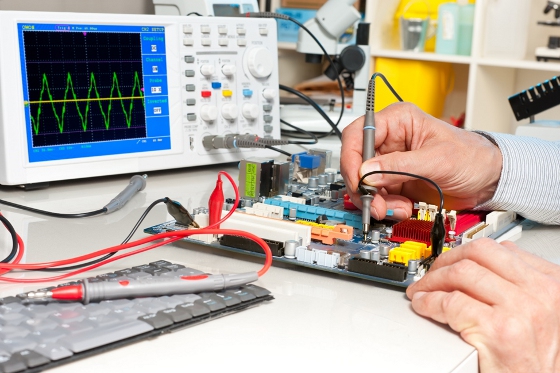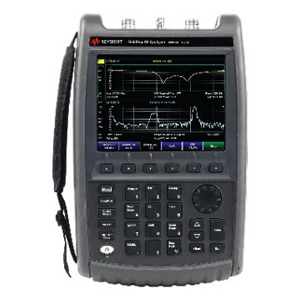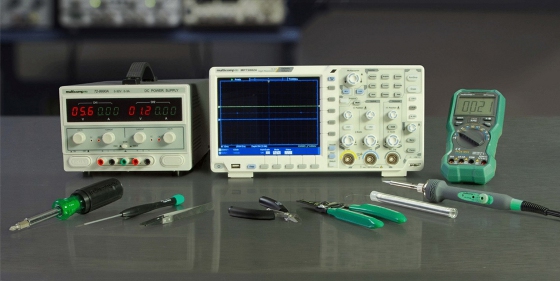 |
| July 16, 2024 | Volume 20 Issue 27 |
Designfax weekly eMagazine
Archives
Partners
Manufacturing Center
Product Spotlight
Modern Applications News
Metalworking Ideas For
Today's Job Shops
Tooling and Production
Strategies for large
metalworking plants
Test equipment advancing to meet rapidly changing market needs

The precision and capabilities of modern oscilloscopes (featured above) are advancing with the electronics development process. [Credit: Photo courtesy of Newark Electronics]
By Maureen Lipps, Multicomp Pro Private Label Product Segment Leader, Test and Tools, Newark Electronics
The technology industry is currently undergoing several major shifts spurred, in part, by the Internet of Things (IoT), which is changing the way information technology handles changes in the world around us. Sensors can now provide real-time data to cloud servers, enabling a wide range of services, including everything from predictive maintenance to smart cities.
5G communications technology not only helps connect IoT devices to the cloud, but also enables services that rely on much higher data rates, such as virtual and augmented reality. Smarter cars are taking advantage of 5G communications to build a better understanding of traffic flow while they sense the environment around them using millimeter-wave radar.
Although these technologies can seem quite disparate, they are all being used to guide research, development, and test strategies forward. For example, the increased demand in energy-efficient technology is moving power electronics away from conventional silicon technologies to those based on wide-bandgap materials such as silicon carbide (SiC) and gallium nitride (GaN). Both support much faster switching than traditional silicon. These materials also offer high-temperature capabilities, particularly in the case of SiC, lending themselves to automotive applications. GaN requires less cooling than silicon, making it suitable for use in smaller, dense radio units that offer features such as massive multiple-input multiple-output (MIMO) and beamforming.
Instruments and probes for high-quality test and measurement
Instruments that can handle high voltages are needed to measure the behavior of wide-bandgap devices. In addition, there is a requirement for specialized test fixtures that are optimized for high-speed and high-power switching to support safe operation.
In addition, the improved properties of power semiconductors mean some of them generate extremely low leakage currents when switched off, which are difficult to measure using standard probes because of noise. Triaxial cables offer a solution by providing a high-quality connection in combination with safety probes.
Probing technology is equally critical in other areas of test for IoT, 5G, and automotive systems. Although the probes supplied as standard with an oscilloscope are typically adequate for basic applications, engineers need to use probes that make it easier to capture small signals or measure slight changes in power consumption as they tune the energy profile of their IoT devices.

Radio frequency (RF) analyzers continue to evolve as RF performance testing is prioritized, such as the N9912A (shown above), a portable, battery-operated RF analyzer. [Credit: Photo courtesy of Newark Electronics]
Multiple and integrated radio frequency test functions are essential
Radio frequency (RF) performance is becoming increasingly critical across the board, from IoT sensor nodes to 5G-enabled systems or in the radar subsystems used by advanced driver assistance systems (ADAS) in motor vehicles. Due to 5G's capabilities and its improved short-range protocols, there is a need to track increased data communication and processing rates.
RF spectrum is becoming so crowded, especially in unlicensed bands, that electronics designers are trying to pack as much data as possible into frequency bands, creating the need for highly advanced modulation schemes or extensions into frequency bands above 10 GHz. These trends increase the complexity of debugging and call for the use of smarter instruments to show the effects of channel distortion and interference on signal quality.
Instrument vendors have responded to this trend by integrating multiple RF test functions into their products. For example, instead of requiring engineers to deal with multiple separate instruments, such as signal generators, spectrum analyzers, and network analyzers, suppliers are integrating all of that functionality into combined units that make testing simpler and easier to perform.
High-quality, compact performance equipment for field operation
Due to the wide range of installation possibilities now available for IoT devices, there is a need for portable high-performance test equipment that can be easily used in the field. Handheld spectrum analyzers, for example, offer the ability to detect spurious signals and track down interference problems.
Even relatively low-end IoT devices typically incorporate multiple functions, ranging from local data processing to high-speed communication. However, engineers have to be able to debug complex system-level issues, which puts a greater emphasis on ease of use and integration in test instruments across the board and not just in RF design. Examples include the integration of signal generators into oscilloscopes and the increasing integration between logic analysis and oscilloscope functions.

Portable and handheld test equipment tools are ideal for field work, such as the range of test equipment and hand tools from Multicomp Pro shown above. [Credit: Photo courtesy of Newark Electronics]
The advantage of this integration is that users can easily see the alignment of related logic and analog signals. For example, if a software loop isn't responding correctly to changes in a sensor input, the alignment onscreen could show that critical deadlines are being missed or that signals are not being latched by an analog-to-digital converter correctly.
Bringing it all together
Although the rise of the IoT, 5G, and advanced automotive electronics markets is instigating rapid changes in technology, test equipment is keeping pace, and not just in extensions to bandwidth specifications or signal resolution. Vendors are now offering higher levels of integration and software content designed to provide greater ease of use.
Learn more about Newark Test & Measurement, Tools, and Production Supplies at newark.com/multicomp-pro-test-and-tools.
Published July 2024
Rate this article
View our terms of use and privacy policy
